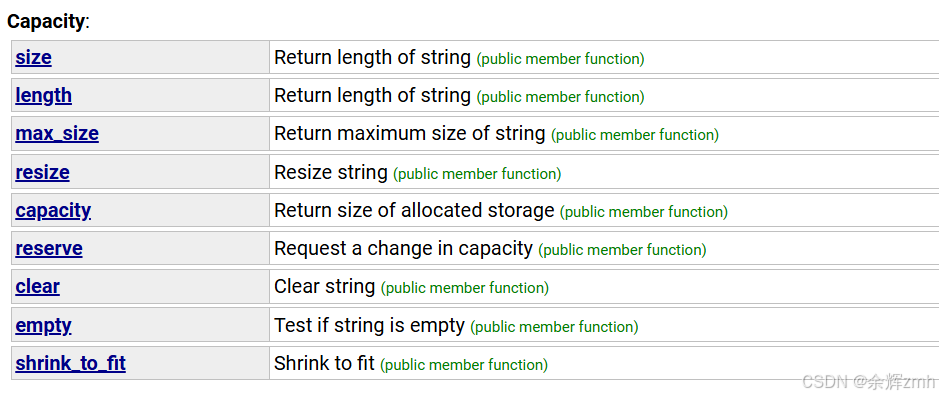✨感谢您阅读本篇文章,文章内容是个人学习笔记的整理,如果哪里有误的话还请您指正噢✨
✨ 个人主页:余辉zmh–CSDN博客
✨文章所属专栏:c++篇–CSDN博客

文章目录
前言一.`std::string`对象的创建二.`std::string`对象的访问三.`std::string`对象的容量四.`std::string`对象的遍历1.使用索引(下标)进行遍历2.使用迭代器进行遍历3.使用范围for进行遍历 五.`std::string`对象的增删查改1.增加2.删除3.查找4.修改 六.`std::string`对象的其他函数使用
前言
在C++编程的世界里,字符串无处不在。无论是用户输入、文件处理,还是网络通信,字符串都是不可或缺的数据类型。然而,直接操作字符数组(即char字符串)不仅繁琐,而且容易出错。幸运的是,C++标准库为我们提供了std::string类,它封装了字符串的底层细节,提供了丰富的成员函数来简化字符串的处理。本篇文章将深入探讨c++中的std::string类的成员函数,包括字符串的创建,遍历,以及增删查改等,带你领略其强大的功能和便捷的操作方式。
注意:
本篇文章资料来源网站:c++:std::string
文章中出现的蓝色字符是对应函数的网站(重要的函数我会附上网站,部分函数没有,有需要的可以根据上面的这个网站自己查找噢)
一.std::string对象的创建
以下是一些常用的std::string对象的创建
默认(无参)构造对象:
创建一个无参对象,也就是空字符串。
std::string s1;带参构造对象:
创建一个非空字符串。
std::string s2("hello world");//打印结果:hello world用指定数量的字符构造对象:
std::string s3(5,'*');//打印结果:*****用另一个std::string对象构造:
相当于对std::string对象拷贝构造
std::string s2("hello world");std::string s3(s2);//打印结果:hello world用子字符串构造:
从已存在的对象指定位置开始拷贝
std::string s2("hello world");//从s2对象的下标为6开始拷贝,拷贝数量为5std::string s4(s2,6,5);//打印结果:world二.std::string对象的访问
std::string对象常用的访问方式有下面四种:

其中operator []和at()这两种方式是比较常用的,都是用于访问字符串中特定位置的字符。
at(): at()方式接受一个索引值作为参数,返回索引值上的字符,如果索引值超过字符串的有限范围,就会抛出一个std::out_of_range异常。

以下面代码为例:
#include<iostream>#include<string>using namespace std;int main(){string s1("hello world");try {char ch = s1.at(13);}catch (const out_of_range& e) {cerr << "Caught an out_of_range exception:" << e.what() << '\n';}return 0;}当索引值为13时,超过字符串的有限范围,抛出异常并被捕获处理:

operator[]:该操作符也可以接受一个索引值作为参数,返回该索引值上的字符,但是和at()方式不同的是,operator []在索引值超出字符串的有限范围时,不会抛出异常,可能会导致未定义行为,导致程序的崩溃或产生意外结果。

#include<iostream>#include<string>using namespace std;int main(){ string s1("hello world"); char ch = s1[13]; cout << ch << endl;}
总结:at()和operator []两种方式都可以用于访问std::string对象中的字符,但at()提供了更高的安全性,而operator []则提供了更好的性能。选择使用哪个时,需要根据具体的使用场景和对安全,性能的要求来决定。
三.std::string对象的容量
在c++中std::string类提供了多种成员函数来操作和查询字符串的容量和大小等属性,以下是关于所有capacity的成员函数:

下面重点讲解一些常用的函数和使用方式:
size()/length():返回字符串有效长度(也就是字符串的字符个数),这两个函数是等价的。using namespace std;string s1("hello world");cout << s1.size() << endl;cout << s1.length() << endl;//输出结果都为11capacity():返回当前分配的存储空间的大小(空间总大小),这个值可能大于或等于size()返回的值。
using namespace std;string s1("hello world");cout << s1.size() << endl;cout << s1.capacity() << endl;//输出结果size为11,capacity为15
reserve():更改字符串的容量至少为n,该函数不会改变字符串的大小,只是确保有足够的空间来存储至少n个字符。
using namespace std;string s1("hello world");cout << "reserve前:" << endl;cout << s1.size() << endl;cout << s1.capacity() << endl;s1.reserve(20);cout << "reserve后:" << endl;cout << s1.size() << endl;cout << s1.capacity() << endl;
resize():将字符串的大小调整为n,如果n大于当前字符串的大小,则用默认字符(通常为0,如果使用reserve(n,ch)则是字符ch)填充新位置;如果n小于当前字符串的大小,则字符串截断。
using namespace std;string s1("hello world");cout << s1 << endl;//0填充新位置s1.resize(15);//字符串截断s1.resize(6);cout << s1 << endl;

clear():清空字符串,使其大小为0。
using namespace std;string s1("hello world");s1.clear();cout<<s1.size()<<endl;//输出结果为0empty():检查字符串是否为空,如果为空,返回true,如果不为空,则返回false。
using namespace std;string s1("hello world");string s2;cout << s1.empty() << endl;//返回值为true(1)cout << s2.empty() << endl;//返回值为false(0)四.std::string对象的遍历
当有一个字符串时,我们肯定少不了对该字符串进行遍历。
在c++中,std::string类提供了多种方法进行字符串的遍历,以下是几种常用的遍历方式:
1.使用索引(下标)进行遍历
通过前面的operator []和at()两种方式可以对std::string对象进行遍历:
#include<iostream>#include<string>using namespace std;int main(){string s1("hello world");for (size_t i = 0; i < s1.size(); i++) {cout << s1[i] << " ";}cout << endl;for (size_t i = 0; i < s1.size(); i++) {cout << s1.at(i) << " ";}cout << endl;return 0;}打印结果如下,两种方式结果相同:

2.使用迭代器进行遍历
在c++中,std::string类提供了迭代器(iterators),用于遍历字符串,这些迭代器可以像访问数组一样访问字符串中的字符,以下是std::string类关于迭代器(iterators)所有的成员函数:

begin()和end():
begin()返回一个指向第一个字符的迭代器,end()返回一个指向字符串最后一个字符的下一个位置的迭代器(用于普通std::string类对象的从前往后遍历)。
#include<iostream>#include<string>using namespace std;int main() {string s1("hello world");//iterator是像指针一样的类型(可能是指针,也可能不是),使用时需要加string::string::iterator it = s1.begin();while (it != s1.end()) {cout << *it << " ";it++;}cout << endl;return 0;}cbegin()和cend():
和begin(),end()功能相同,不同点是cbegin()和cend()用于const std::string类对象的从前往后遍历且不能对该对象进行修改。
#include<iostream>#include<string>using namespace std;int main() {const string s1("hello world");//const_iterator是像指针一样的类型(可能是指针,也可能不是),使用时需要加string::string::const_iterator it = s1.cbegin();while (it != s1.cend()) {cout << *it << " ";it++;}cout << endl;return 0;}rbegin()和rend():
rbegin()返回一个指向最后一个字符的反向迭代器,rend()返回一个指向第一个字符的前一个位置的反向迭代器(用于普通std::string类对象的从后往前遍历)。
#include<iostream>#include<string>using namespace std;int main() {string s1("hello world");//reverse_iterator是像指针一样的类型(可能是指针,也可能不是),使用时需要加string::string::reverse_iterator rit = s1.rbegin();while (rit != s1.rend()) {cout << *rit << " ";rit++;} cout<<endl;return 0;}crbegin()和crend():
和rbegin(),rend()功能相同,不同点是crbegin()和crend()用于const std::string类对象的从后往前遍历且不能对该对象进行修改。
#include<iostream>#include<string>using namespace std;int main() {const string s1("hello world");//const_reverst_iterator是像指针一样的类型(可能是指针,也可能不是),使用时需要加string::string::const_reverse_iterator rit = s1.crbegin();while (rit != s1.crend()) {cout << *rit << " ";rit++;}cout << endl;return 0;}上面四种遍历方式的结果:

3.使用范围for进行遍历
在c++入门讲解的时候有关于范围for的使用讲解(详细可以看我之前的文章c++入门二),在对std::string对象进行遍历时同样可以使用范围for,而范围for的底层原理就是上面讲解的迭代器。
#include<iostream>#include<string>using namespace std;int main() {string s1("hello world");//auto关键字可以自动推演ch的类型//像上面迭代器使用的类型如:string::iterator 可以直接使用autofor (auto ch : s1) {cout << ch << " ";}cout << endl;return 0;}
五.std::string对象的增删查改
1.增加
append():在字符串的末尾追加内容,可以是c风格的字符串,std::string对象,字符数组的子串或者是单个字符。
string s1("hello");s1.append(" ");s1.append("world");s1.append("!");cout << s1 << endl;//输出结果:hello world!operator+=:和append()功能相似。
string s1("hello");s1 += " ";s1 += "world";s1 += "!";cout << s1 << endl;//输出结果:hello world!push_back():在字符串的末尾添加单个字符,push_back较为少用,没有operator+=和append()使用起来方便。
string s2("hello world");s2.push_back('!');cout << s2 << endl;//输出结果为:hello world!insert():在字符串的指定位置插入新内容,可以是c风格的字符串,std::string对象,字符数组的子串或者是单个字符。
string s3("hello");s3.insert(5, " world!");cout << s3 << endl;//输出结果为:hello world!2.删除
erase():从字符串中删除指定位置或范围的字符,参数可以是单个位置,一个位置和长度或者两个位置来指定删除范围。
string s1("hello world");s1.erase(8, 10);//删除从下标8到10位置的字符cout << s1 << endl;//输出hello wos1.erase(5);//删除下标5之后的字符cout << s1 << endl;//输出hellopop_back():删除字符串末尾的字符,该函数不能传参。
string s2("hello world!");//删除最后一个字符'!'s2.pop_back();cout << s2 << endl;//输出hello world3.查找
fand():在字符串中查找子串或者字符的首次出现位置,参数可以是要查找的子串或字符,以及可选的查找起始位置。未查找到时返回string::npos(下面三个函数同理)。
注意:string::npos是std::string类中的一个静态成员变量,npos的值通常设置为size_t类型(无符号整形)的最大值,用于表示一个不可能在字符串中出现的位置。
#include<iostream>#include<string>using namespace std;int main() {string s1("hello world");cout << s1.find("world") << endl;//输出下标位置为6cout << s1.find("zmh") << endl;//找不到,输出size_t类型的最大值return 0;}rfand():查找子串或字符在字符串中最后一次出现的位置,参数和fand()相同。未查找到时返回string::npos。
#include<iostream>#include<string>using namespace std;int main(){ string s1("hello world"); cout << s1.rfind("l") << endl; //查找字符’l'最后一次出现的位置,输出下标位置9 cout << s1.find("zmh") << endl; //找不到,输出size_t类型的最大值 return 0;}find_first_of():在字符串中查找任何与指定字符集中的字符首次匹配的位置,参数可以是字符集,以及可选的查找起始位置。
#include<iostream>#include<string>using namespace std;int main() {string s1("hello world");string set("auto");size_t first_pos = s1.find_first_of(set);if (first_pos != string::npos) {cout << first_pos << endl;}else {cout << "No find" << endl;}return 0;}//输出结果为4,在s1字符串下标为4的位置首次与字符串set匹配find_last_of():在字符串中查找任何与指定字符集中的字符最后一次匹配的位置,参数和find_first_of()相同。
#include<iostream>#include<string>using namespace std;int main() {string s2("hello world");string ret("auto");size_t last_pos = s2.find_last_of(ret);if (last_pos != string::npos) {cout << last_pos << endl;}else {cout << "No find" << endl;}return 0;}//输出结果为7,在s1字符串下标为7的位置最后一次与字符串ret匹配4.修改
assign():给字符串赋值,可以视为一种修改操作,参数可以是c风格的字符串,std::string对象,字符数组的子串或者是单个字符。
#include<iostream>#include<string>using namespace std;int main() {string s1;s1.assign("!");cout << s1 << endl;s1.assign("hello");cout << s1 << endl;return 0;}//第一次输出结果为!//第二次输出结果为helloreplace():替换字符串中的部分内容,参数包括要替换的起始位置和长度以及替换内容。
#include<iostream>#include<string>using namespace std;int main() {string s2("hello world");s2.replace(6, 4, "auto");cout << s2 << endl;return 0;}//从下标为6的位置开始,替换长度为4的auto的字符//输出结果为hello autodsubstr():返回一个子串,虽然substr()本身不能进行修改,但可以通过它获得子串并进行修改,然后可能需要将修改后的子串重新赋值给原字符串的一部分。
#include<iostream>#include<string>using namespace std;int main() {string s1("hello world");//获取s1字符串下标6到10位置的子串赋值给s2string s2 = s1.substr(6, 10);cout << s2 << endl;return 0;}//输出结果为world六.std::string对象的其他函数使用
operator+:运算符+重载,用于将两个字符串对象连接在一起,并返回一个连接后的字符串,operator+和operator+=的区别是,operator+不改变原字符串,operator+=改变原字符串
#include<iostream>#include<string>using namespace std;int main() {string s1("hello");string s2(" world");string result = s1 + s2;cout << s1 << endl;cout << s2 << endl;cout << result << endl;return 0;}//第一个输出结果为hello//第二个输出结果为 world//第三个输出结果为hello worldoperator<<:流插入运算符<<重载属于标准库std::ostream中的,是一个非成员函数,他接受一个std::ostream的引用和一个std::string的引用作为参数,并将std::string对象中的内容写入到输出流中。这个运算符返回对std::ostream的引用。
operator>>:流提取运算符>>重载属于标准库std::istream中的,是一个非成员函数,他接受一个std::istream的引用和一个std::string的引用作为参数,并将std::string对象中的内容写入到输入流中。再从输入流中提取数据,返回对std::istream的引用。
#include<iostream>#include<string>using namespace std;int main() {string name;cout << "请输入姓名:" << endl;cin >> name;cout << name;return 0;}c_str():将std::string对象内部存储的字符串数据转换为一个以空字符’\0’为结尾的c格式字符串(const char*)类型。
string s1("hello\0world");cout << s1.c_str() << endl;//输出结果为hello//遇到空字符结束以上就是关于c++中std::string类的讲解,如果哪里有错的话,可以在评论区指正,也欢迎大家一起讨论学习,如果对你的学习有帮助的话,点点赞关注支持一下吧!!!
